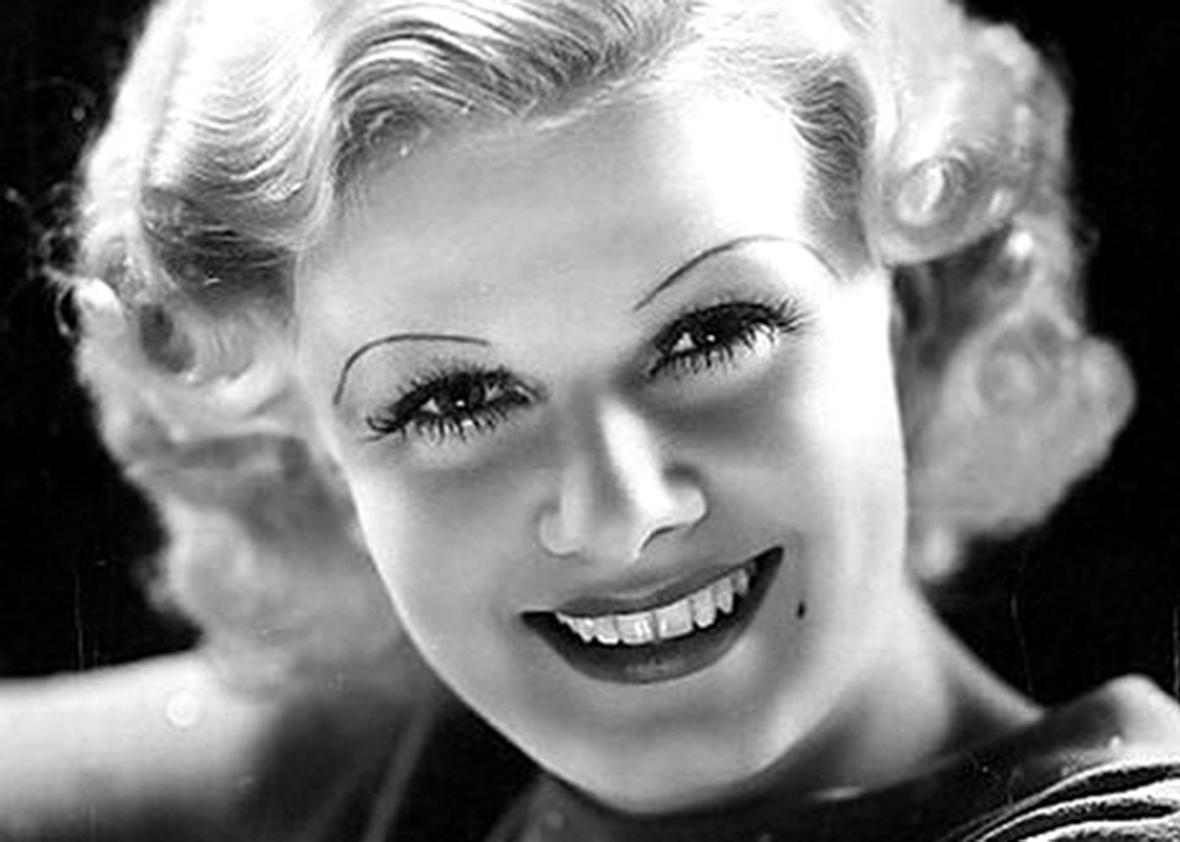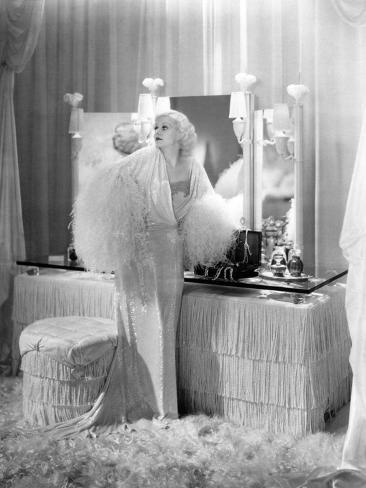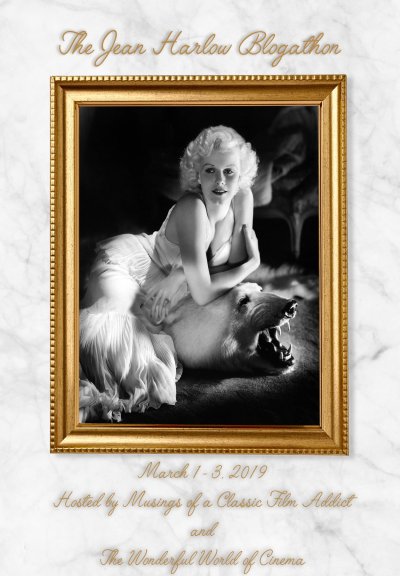Jean Harlow é uma das minhas atrizes
favoritas. Ela podia fazer tanto comédia quanto drama com perfeição, ela
seduzia como ninguém, ela era charmosa e tinha um sorriso adorável – na
verdade, eu acredito que ela era uma pessoa adorável. E ela era maravilhosa. Eu
sei que a maioria das fotos eram posadas e com muita maquiagem, mas não há uma
foto de Jean em que ela não pareça uma deusa. Por isso eu pensei: o que Jean
Harlow fazia para ser tão encantadora?
Jean Harlow
is one of my favorite actresses. She could do both comedy and drama with
perfection, she could seduce like no one, she was charming and had a lovely
smile – in fact, I believe she was lovely to be around. And she was marvelous.
I know that most are glamour photos, especially posed and with lots of make-up,
but there is not one picture of Jean in which she doesn't look like a goddess.
So I thought: what did Jean Harlow do to be so alluring?
Começamos
com as sobrancelhas. Nos anos 30, sobrancelhas muito finas estavam na moda, e
muitas mulheres escolhiam remover completamente suas sobrancelhas naturais e
desenhar uma nova com maquiagem. As sobrancelhas de Jean eram muito curvadas, o
que dava um toque dramático ao visual. Eu ainda prefiro minhas sobrancelhas
naturais e espessas – nada da moda de 1930.
We begin with
the eyebrows. In the 1930s, incredibly thin eyebrows were fashionable, and many
women chose to pluck away their natural eyebrows completely and then draw a
thin new one with makeup. Jean's eyebrows were very curved, which added drama
to the look. I actually prefer my natural, wider eyebrows than the 1930s
fashion.
Para os
olhos, Jean provavelmente seguia a moda, usando sombra para chamar a atenção
para os olhos e rímel apenas nos cílios inferiores para levantar o olhar.
Algumas fontes dizem que ela tinha cílios naturalmente longos – como eu não
tenho, eu costumo usar rímel apenas nos cílios superiores, mas devo confessar
que usá-lo nos cílios inferiores faz uma grande diferença.
For her eyes,
Jean probably went on with the fashion, using eye shadows to drive attention to
the eyes and mascara only in the lower lashes to lift her eyes out. Some
sources said she had naturally long upper lashes – since I don’t, I actually
use mascara only in the upper lashes, but I must confess that using them in the
lower lashes makes a good difference.
Depois, a pintinha. A pinta no rosto de Jean Harlow era migrante. Por muito
tempo, pintas foram desejadas e, se você não tivesse uma, podia fazer uma. Foi
o que Jean fez, mas ela mudava sempre a localização do pequeno detalhe no
rosto.
Then, the
beauty mark. Jean's beauty mark was a migrating one. For a long
time beauty marks were desired and, if you didn’t have one, you could fabricate
one. Jean did that, but kept changing the location of the little detail in her
face.
E há
também o cabelo. Eu imediatamente desisti da ideia de me tornar uma loira
platinada porque cabelo loiro não me favorece, mas é interessante ler sobre o
cuidado de Jean com o cabelo. Ela tinha uma ótima parceria com Max Factor, o
homem por trás da marca de cosméticos. Foi Max que inventou o termo “Blonde
Bombshell”, e ele foi também responsável por platinar o cabelo de Jean pela
primeira vez. Ela usava um descolorante primitivo para conseguir o tom
platinado, e alguns sites dizem que ela usava “peróxido, amônia, água sanitária
e Lux Flakes (um tipo de sabão em pó)” – isso, contudo, é difícil de ser
confirmado porque a fonte citada é o cabeleireiro Alfred Pagano, que tinha
apenas 18 anos quando Jean faleceu. Mas uma coisa é certa: o processo de
tintura do cabelo não contribuiu com a morte prematura de Jean.
Then there is
the hair. I immediately scratched the idea of becoming a platinum blonde
because blonde hair doesn't suit me, but it's interesting to read about Jean's hair
care routine. Jean had a nice partnership with Max Factor, the man behind the
cosmetics brand. It was Max that invented the term “Blonde Bombshell”, and he
was also responsible for first dying her hair platinum blonde. She used a
primitive bleach to achieve the platinum hair tone, and some sites cite that
she used “peroxide, ammonia, Clorox and Lux Flakes (a kind of washing powder)”
– this, however, is hard to confirm because the source cited is hairdresser
Alfred Pagano, who was only 18 when Jean passed away. But one thing is certain:
the process to die her hair didn’t contribute with her premature death.
De fato,
em 1933 Jean fez propaganda de alguns produtos Max Factor para a revista
Photoplay:
Actually, in
1933 Jean advertised some Max Factor products for the Photoplay magazine:
Ainda em
1933 Jean escreveu – é mais provável que um ghost writer tenha escrito – várias
dicas de beleza para numerosos jornais. Estas dicas foram publicadas em inglês
no site Classic Blondes. Aqui estão algumas dicas publicadas no jornal Honolulu
Examiner. A dica de sete de novembro de 1933 é:
“Limpe seu rosto com água e sabão pelo menos
uma vez ao dia. Se sua pele é muito seca, no entanto, duas vezes por semana é
suficiente. Depois, enxágue com água fria, seque com batidinhas de uma toalha
macia, e aplique um creme de limpeza. No resto do tempo, use água fria e uma
loção de limpeza ou enxaguante.”
Ei, eu
venho fazendo isso há anos! Como minha pele não é seca, eu lavo o rosto todas
as noites para remover a maquiagem e então uso água fria (para fechar os poros)
e uma toalha macia. Ha!
Also in 1933
Jean wrote – or, probably, a ghost writer wrote – many beauty tips for numerous
newspapers. Those tips were first published in the site Classic Blondes. Here
are some of them as they were published at the Honolulu Examiner. Her beauty
tip from November 7th, 1933 is:
“Give your
face a soap and water cleansing at least once a day. If your skin is very dry,
though, twice a week is sufficient. Follow it with a cold-water dash, pat dry
with a soft towel, and apply cleansing cream. At other times, use cool water
and a cleansing lotion or rinse.”
Hey, I've
been doing that for years! Since my skin is not dry, I wash it every night to
remove the makeup and then use cold water (to close the pores) and a soft
towel. Ha!
21 de novembro de 1933:
“Remova creme / maquiagem da pele com batidinhas. Não
esfregue sua pele. Uma batidinha gentil vai revigorar os tecidos sem danificá-los.
Você verá que quadradinhos de gaze são excelentes para isso. Deixe um monte na
sua penteadeira sempre.”
Mais uma
dica que eu já seguia. Eu costumo usar discos de algodão para remover
maquiagem.
November 21st,
1933:
“Remove cold
cream from your face by patting. Do not rub your skin. A gentle patting will
invigorate the tissues without breaking them down. You will find squares of
soft cheesecloth excellent for this purpose. Keep a supply always at your
dressing table.”
Another tip
that I followed already. I actually use cotton discs to remove makeup.
21 de novembro de 1933:
“Batom
deve combinar com blush. Não deixe o batom ser o destaque no seu rosto. Aplique
o batom na sua boca com a ponta do seu dedo. Para dar a ilusão de maior
preenchimento, aplique um pouco de batom acima da linha dos lábios. Use um tom
de batom mais claro à noite.”
Eu já
tinha ouvido que não se deve aplicar o batom diretamente na boca. Por causa de
Jean, eu tentei aplicá-lo com meu dedo. O resultado foi um tom bem mais claro
do que o original, mas também uma cobertura mais uniforme dos lábios – e uma
chance maior de aplicar batom para fora dos lábios. Aplicar batom fora dos
limites dos lábios pode gerar um bom resultado no cinema, mas o efeito no dia a
dia é estranho. E eu costumo usar um tom mais escuro de batom à noite. Os
lábios de Jean eram pintados em formato de coração, uma moda dos anos 20, e eu
acho que é uma moda adorável – e que eu adoro imitar.
November 22nd,
1933:
“Lip rouge
should blend with cheek rouge. Don't let it be the most conspicuous thing on
your face. Apply the lip rouge on your mouth with the tip of your finger. To
give the illusion of greater fullness, put the lip rouge a trifle over the
natural lip line. Use a lighter shade of lip rouge at night than in the
daytime.”
I had already
heard that you shouldn’t apply the lipstick directly in your mouth. Because of
Jean, I tried to apply it with my finger. The result was a much lighter shade
than the original, but also a more uniform coverage of the lips – and a bigger
chance to apply lipstick off the limits of the lips. Applying lipstick over the
natural lip line may photograph well, but the effect in day-to-day life is
weird. Also, I tended to use darker lipstick at night than during the day. Jean’s
lips were painted into a “cupid’s bow”, a trend in the 1920s, and I think this
is definitely cute – a trend I love to copy.
 |
| Jean's lips in a photo by @harlowheaven |
24 de
novembro de 1933:
“Escove
seus dentes com um movimento circular gentil, não para cima e para baixo. Faça
uma massagem vigorosa nas gengivas com sal comum e uma escova de borracha. Isso
deixará as gengivas saudáveis. Nesses tempos de comida mole e pouca mastigação,
as gengivas precisam de exercício.”
Minha
dentista me ensinou a escovar meus dentes com movimentos circulares muitos anos
atrás – e eu mantive o hábito. Mas massagear as gengivas com sal? Bem, o sal é
abrasivo, e irá pouco a pouco danificando o esmalte dos dentes, então... de
jeito nenhum.
 |
| Via Curious Pip |
November 24th,
1933:
“Brush your
teeth with a gentle circular movement, not up and down. Give the gums a
vigorous massage with table salt and rubber massage brush. This will keep them
in a healthy condition. In these days of soft food and little chewing, the gums
need exercise.”
My dentist
taught me to brush my teeth with circular movements many years ago – a habit I
keep. But the salt in the gum? Well, salt is abrasive, and it’ll slowly damage
the tooth enamel so… big no.
25 de
novembro de 1933:
“Faça uma
massagem no couro cabeludo com azeite aquecido pelo menos uma vez ao mês. Isso
vai estimular os tecidos e nutrir o couro cabeludo e o cabelo. Alguns minutos
de massagem e escovação toda noite também estimulará o crescimento do cabelo e
dará brilho. Escove para cima, partindo do couro cabeludo. Eu saio sem chapéu
sempre que posso para arejar meu cabelo.”
Azeite
quente é coisa do passado, mas sessões mensais de hidratação foram comuns na
minha vida alguns anos atrás – mas, infelizmente, fizeram meu cabelo cair em
grande volume. A ideia de escovar o cabelo toda noite parece muito com o mito
de “100 escovadas” – escovar excessivamente o cabelo pode enfraquecê-lo. Eu
também saio sem chapéu sempre que posso – ou seja, o tempo todo.
November 25th,
1933:
“Give your
scalp a hot olive massage at least once a month. This will stimulate the
tissues and nourish the scalp and hair. A few minutes' brushing and massaging
every night will also stimulate the growth of the hair and give it a brilliant
luster. Brush upward, lifting the hair off the scalp. I go without a hat
whenever I can to give the hair an airing.”
Hot olive is
a thing from the past, but monthly sessions of hair hydration were common in my
life a few years ago – but, unfortunately, made my hair fall more. The brushing
upward every night sounds a lot like the “100 strokes myth” – excessive
brushing can make the hair weaker. I also go without a hat whenever I can –
which is almost all the time.
 |
| Via Curious Pip |
27 de novembro de 1933:
“Sempre
adicione uma nota de uma cor contrastante ao seu figurino. Um lenço cor de rubi
no bolso de um terno escuro, um cachecol cor de jade com um vestido branco, uma
flor cor de fogo no ombro de um vestido cinza irão adicionar interesse e vitalidade
à sua aparência.”
Parece-me
uma grande ideia para quebrar a sobriedade de alguns figurinos. Embora eu use
roupas mais coloridas, esta é uma dica que eu seguirei constantemente.
November 27th, 1933:
“Always
add one note of vividly contrasting color to
your costumes. A crimson-colored handkerchief in the pocket of a dark colored
suit, a jade green scarf with a white dress, a flame-colored flower on the
shoulder of a gray frock will add interest and vitality to your appearance.”
This sounds
like a great idea to break the sobriety of some outfits. Although I wear more
colorful outfits, this is a tip I’ll follow often.
Em 1933,
Jean Harlow também fez um “tutorial de maquiagem” para a revista Photoplay:
In 1933, Jean
Harlow also did a “makeup tutorial” for Photoplay magazine:
Em 1934,
um livreto do filme “Boca para Beijar / The Girl from Missouri”, Jean contradiz
algumas das dicas de beleza já publicadas – ela diz que não usa maquiagem
frequentemente – mas a coisa mais interessante é o que ela diz sobre seu
cabelo:
In 1934, in a
press book for “The Girl from Missouri”, Jean contradicts a few of the beauty
tips published before – she says that she doesn’t wear makeup that often – but the
most interesting thing is what she says about her hair:
“Não há
truques no cuidado com meu cabelo. Eu uso sabão de Castela (sabão feito com
azeite de oliva e hidróxido de sódio) e lavo como todo mundo. Eu nunca uso
condicionador. Eu lavo meu cabelo a cada quatro dias, mas eu esfrego óleo de
rícino no meu couro cabeludo antes de cada lavagem.”
“There are no
tricks to the care of my hair at all. I use castile soap (a soap made with
olive oil and sodium hydroxide) and shampoo it like everyone else might do. I
never use a rinse. I shampoo it every four days, but I rub hot castor oil into
my scalp before every shampoo.”
Eu também
não uso condicionador. Mas óleo de rícino definitivamente não é parte da minha
rotina de beleza. Para ler todas as dicas de beleza no livreto, acesse o blog Harlean’s Heyday (em inglês).
I never use
rinse either. But castor oil is not part of my beauty routine. To read all the
beauty tips in the press book, go to the blog Harlean’s Heyday.
Porém,
mais uma vez, em uma entrevista de 1935, ela diz que precisa lavar o cabelo três
vezes por semana quando está de férias, e toda noite quando está gravando.
Parece que, assim como muitos outros detalhes na Hollywood do Sistema de
Estúdio, segredos de beleza eram inventados, publicados e manipulados para
permanecerem isso: um segredo.
But, once
again, in a 1935 interview, she says she needs to wash her hair three times a
week when she is on vacation, and every night when she is shooting a film. I
guess that, just like many other details in the Studio Era Hollywood, beauty
secrets were invented, publicized and manipulated to remain this: a secret.
This is my
contribution to the Jean Harlow blogathon, hosted by Virginie and Samantha at
The Wonderful World of Cinema and Musings of a Classic Film Addict.


















2 comments:
Very interesting article Leticia! I think it's a great and fun addition to our blogathon! I think thin painted eyebrows will look terrible on me lol but it suited Jean well. Thanks so much for your contribution!
This is such an awesome contribution to our blogathon! I had no idea that Jean shared so much of her beauty knowledge in her lifetime, and I definitely didn't know how simple some of these tricks were. I already do a lot of them, but now I'll think of Jean when I do!
Post a Comment